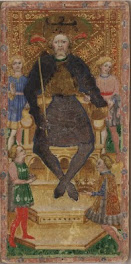
The London Book Review has
a review of the exhibition on "the most famous codex of them all," Codex Sinaiticus at the British Library in London. The exhibition coincides with making the codex available online. (See it
here.) Peter Campbell writes,
The library holds 347 leaves of the Sinaiticus, bought in 1933 (there was a public subscription) from the Russian government. They arrived as a single, coverless stack of quires. Now bound as two volumes they can be seen in the library’s gallery. Another 43 leaves are in the university library in Leipzig, parts of six are in St Petersburg. Twelve leaves and 40 fragments, recovered by monks in 1975 from a space uncovered during building work, are still in the Monastery of St Catherine, Mount Sinai. That was where the Leipzig archaeologist Constantin von Tischendorf was finally shown the bulk of the Sinaiticus in 1859 (he’d taken the other pages away in 1844). He eventually persuaded the monks to present it to the tsar.
Written out in the mid-fourth century, the Sinaiticus originally consisted of 730 parchment leaves measuring 380mm by 345mm. Most of the pages are set out in four narrow columns, but metrical passages – the Psalms, for instance – are in two. The text, written in Greek capitals without word breaks, is in brown ink with some words and lines in red. The Sinaiticus, very plain and very grand, and a manuscript in the Vatican of about the same date share the distinction of being the earliest extant manuscripts of the Christian Bible: that is, of the Greek text of the Septuagint (the Old Testament in the version that was adopted by early Greek-speaking Christians) and the Christian New Testament. This material, made into a single monumental volume, gave physical expression to the idea that the New Testament recorded the fulfilment of prophecies in the Old Testament. Its form – codex, not scroll – emphasised its difference from the Jewish scriptures it included.
The Sinaiticus is much corrected. On the website a transcription in which inserted or over-written letters and words are highlighted accompanies the image of each manuscript page. The alterations are, in modern terms, copy editors’ or proofreaders’ work – spellings corrected, the odd missing word inserted. Some corrections were made while the original work was in progress, others much later, but the striking fact is that the text of the New Testament pages has changed hardly at all since it was first written down – the Sinaiticus is an edition of an established text. The Hebrew scriptures took their canonical form much later. With the New Testament there was no place for a sub-editor to clarify meaning or cure infelicities. Editorial care can express reverence for such a text; the editor’s reward may be the insights thoughtful analysis brings him or her rather than new readings discovered. The work put into a new edition of Shakespeare’s Sonnets, say, is not going to result in a text so different from the last that even the most careful reader will feel he’s been offered a new experience. In religious texts, however, error can be scandalous, and the British Library display includes copies of Bibles in which (it’s hard to imagine it was always accidental) mischievous compositors introduced corruptions. The ‘adulterer’s Bible’ of 1631 omits a ‘not’ so that Exodus 20.14 reads ‘Thou shalt commit adultery,’ and, in Deuteronomy 5.24, replaces ‘greatness’ to give: ‘The Lord hath showed us his glory and his great arse.’ The printers were fined £300 and lost their licence to print.
The Sinaiticus, earlier, and in many things more authoritative than other sources, is a starting point for new editions and translations. After its removal from Mount Sinai, technology paid it the tribute of state of the art facsimiles. In the 19th century fonts were specially cut to match the original characters, in the 20th reproductions of photographs of the pages were printed in collotype – then the most prestigious of printing processes. The digitised codex is the 21st century’s best shot.
 The London Book Review has a review of the exhibition on "the most famous codex of them all," Codex Sinaiticus at the British Library in London. The exhibition coincides with making the codex available online. (See it here.) Peter Campbell writes,
The London Book Review has a review of the exhibition on "the most famous codex of them all," Codex Sinaiticus at the British Library in London. The exhibition coincides with making the codex available online. (See it here.) Peter Campbell writes,

No comments:
Post a Comment